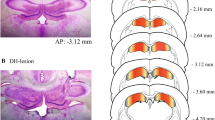Summary
Previous experimental evidences showed that the caudate nucleus has a modulatory effect on hippocampal epilepsy. The caudate's regulating action might reach the hippocampus either via the septal region or, retrogradely, via the accumbens nucleus. In order to obtain new data about the pathway involved in caudate hippocampal influence the spreading of abnormal activity towards the nucleus accumbens was studied. Furthermore the effects of caudate stimulation in animals with electrolytic lesions of the nucleus accumbens were analyzed. It was observed that abnormal penicillin-induced activity spreaded from the hippocampus to the nucleus accumbens in about 30 minutes. In animals with and without lesions of nucleus accumbens, caudate stimulation brought about a significant decrease in the frequency and amplitude of hippocampal activity. The results suggest that the nucleus accumbens is reached by the spreading of hippocampal epilepsy but does not participate in the control exerted by the caudate nucleus on the hippocampus. Thus the caudate-induced inhibition takes place through an anterograde caudate-hippocampal circuit, while at the same time excluding retrograde activation by way of a caudate-accumbens-hippocampal pathway.
Similar content being viewed by others
References
Conrad LCA, Pfaff DN (1976) Autoradiographic tracing of the nucleus accumbens in the rat. Brain Res 113:589–596
Garant DS, Gale K (1987) Substantia nigra-mediated anticonvulsant actions: role of nigral output pathways. Exp Neurol 97:143–159
Iadarola MJ, Gale K (1982) Substantia nigra: site of anticonvulsant activity mediated by γ-aminobutyric acid. Science 218:1237–1240
Jung R (1949) Hirnelektrische Untersuchungen über den Elektrokrampf: die Erregungsabläufe in corticalen Hirnregionen bei Katze und Hund. Arch Psychiat Nervenkr 183:206–244
La Grutta V, Sabatino M (1988) Focal hippocampal epilepsy: effect of caudate stimulation. Exp Neurol 99:38–49
La Grutta V, Sabatino M (1990) Substantia nigra-mediated anticonvulsant action: a possible role of a dopaminergic component. Brain Res 515:87–93
La Grutta V, Sabatino M, Ferraro G, Liberti G, La Grutta G (1986a) Modulation of paroxysmal activity in the hippocampus by caudate stimulation in the chronic cat. Neurosci Lett 67:251–256
La Grutta V, Sabatino M, Ferraro G, Liberti G, La Grutta G (1986b) Hippocampal seizures and striatal regulation: a possible functional pathway. Neurosci Lett 72:277–282
La Grutta V, Sabatino M, Gravante G, La Grutta G (1985) Effect of caudate nucleus on paroxysmal activity in hippocampus of cat. Electroenceph Clin Neurophysiol 61:416–421
Lothman EW, Hatlelid JM, Zorumski CF (1985) Functional mapping of limbic seizures originating in the hippocampus: a combined 2-deoxy-glucose and electrophysiologic study. Brain Res 360:92–100
Nauta WJH, Smith GP, Faull RLM, Domesick V (1978) Efferent connections and nigral afferents of the nucleus accumbens septi. Neuroscience 3:385–401
Powell EW, Leman RB (1976) Connections of the nucleus accumbens. Brain Res 105:289–403
Raisman G, Cowan WM, Powell TPS (1966) An experimental analysis of the efferent projection of the hippocampus. Brain Res 89:83–108
Sabatino M, Ferraro G, La Grutta V (1991) Relay stations and neurotransmitters between the pallidal region and the hippocampus. Electroenceph Clin Neurophysiol (in press)
Sabatino M, Gravante G, Ferraro G, Savatteri V, La Grutta V (1988) Inhibitory control by substantia nigra of generalized epilepsy in the cat. Epilepsy Res 2:380–386
Snider RS, Niemer WT (1961) A stereotaxic atlas of the cat brain. University of Chicago Press, Chicago
Sørensen KE, Witter MP (1983) Entorhinal efferents reach the caudato-putamen Neurosci Lett 35:259–264
Swanson LW, Cowan WM (1975) A note on the connections and development of the nucleus accumbens. Brain Res 92:324–330
Tursky L, Cavalheiro EA, Tursky WA, Meldrum BS (1986) Excitatory neurotransmission within substantia nigra pars reticulata regulates threshold for seizures produced by pilocarpine in rats: effects of intranigral 2-amino-7-phosphonoheptanoate and N-methyl-D-aspartate. Neuroscience 28:61–77
Williams DJ, Crossman AR, Slater P (1977) The efferent projections of the nucleus accumbens in the rat. Brain Res 130:217–227
Author information
Authors and Affiliations
Rights and permissions
About this article
Cite this article
Vella, N., Ferraro, G., Caravaglios, G. et al. A feature of caudate control of focal hippocampal epilepsy: evidence for an anterograde pathway. Exp Brain Res 85, 240–242 (1991). https://doi.org/10.1007/BF00230007
Received:
Accepted:
Issue Date:
DOI: https://doi.org/10.1007/BF00230007




